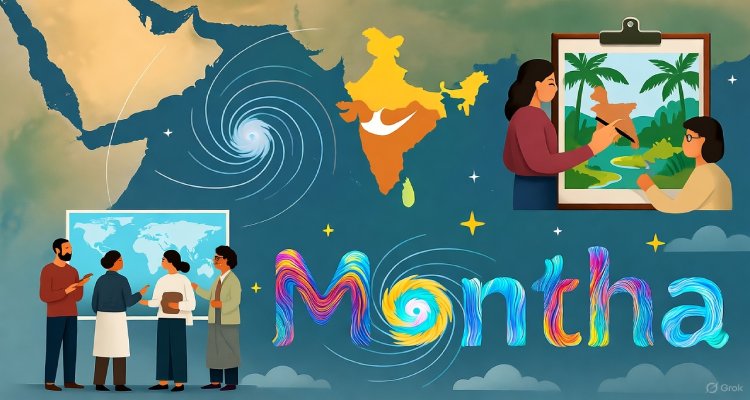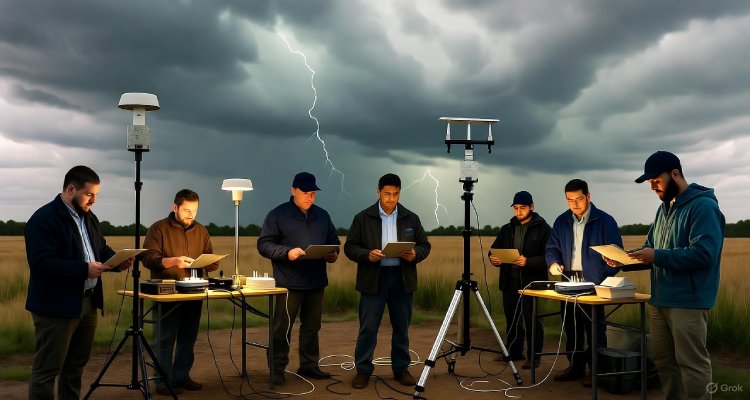How Cyclone ‘Montha’ Got Its Name: The Story Behind the Storm
Cyclone Montha, named by Thailand, means “fragrant flower” in Thai. Here’s how tropical cyclones like Montha are named, the global process behind it, and what it means for India.
Introduction: The Fragrant Fury in the Bay of Bengal
As Cyclone Montha gathers strength over the west-central Bay of Bengal, its name has sparked curiosity as much as its winds. The India Meteorological Department (IMD) confirmed on October 28 that the storm has intensified into a severe cyclonic storm, moving north-northwest toward the Andhra Pradesh coast. With expected wind speeds of 90–100 kmph and gusts up to 110 kmph, Montha isn’t just another tropical cyclone—it carries a name steeped in meaning and international collaboration.
Context: The Birth of a Storm and Its Name
According to the IMD, Cyclone Montha will likely make landfall between Machilipatnam and Kalingapatnam near Kakinada. Heavy rainfall is forecast across Andhra Pradesh and neighboring regions under its influence.
But what does Montha mean, and how was it chosen?
The name “Montha”, proposed by Thailand, translates to “fragrant flower” in the Thai language—a soft, poetic contrast to the storm’s destructive potential. Like every tropical cyclone in the North Indian Ocean, Montha’s name was not chosen at random but through an intricate, regionally coordinated process involving multiple nations and decades of international effort.
Naming the Tempests: The Science of Simplicity
The practice of naming cyclones serves a critical purpose: clarity in communication. Tropical cyclones often coexist in multiple basins worldwide, sometimes lasting weeks. Giving them distinct, easy-to-pronounce names helps meteorologists, governments, and the public avoid confusion.
Historically, storms were identified arbitrarily. One 19th-century Atlantic storm was named “Antje’s hurricane” after a ship it damaged. In the 1940s and 1950s, meteorologists began using women’s names, a practice later expanded to include men’s names in 1979 for gender neutrality and diversity.
In the Atlantic and Southern Hemisphere, storms are named alphabetically, alternating between male and female names. Each year, a new list is used, and after six years, the lists rotate—unless a storm is so deadly or costly that its name is retired permanently.
The Global Framework: How the WMO Organizes Cyclone Names
Cyclone naming is overseen by the World Meteorological Organization (WMO) and its regional committees. There are six Regional Specialized Meteorological Centres (RSMCs) and five Tropical Cyclone Warning Centres (TCWCs) globally, each responsible for their designated oceanic regions.
The India Meteorological Department (IMD) serves as one of these RSMCs. It monitors, names, and issues warnings for cyclones in the North Indian Ocean, covering both the Bay of Bengal and the Arabian Sea.
When a storm’s wind speed exceeds 62 kmph, it qualifies for an official name. IMD also provides cyclone advisories to 13 member countries in its region—a reflection of India’s crucial role in regional meteorology.
Regional Collaboration: The WMO/ESCAP System
In 2004, a unified naming system was introduced for the North Indian Ocean by the WMO/ESCAP Panel on Tropical Cyclones—a partnership among 13 countries including India, Bangladesh, Thailand, Myanmar, Oman, Pakistan, Sri Lanka, and the Maldives.
Each country submits a list of names—neutral in gender, culture, religion, and politics—to ensure inclusivity. The IMD maintains and uses these names sequentially, column by column. Once used, a name is retired forever and cannot be reused.
For instance, earlier names such as Amphan (given by Thailand) and Tauktae (suggested by Myanmar) have been retired after causing widespread destruction.
In 2020, a new list of 169 names was released, replacing the older set of 64. These names, including Montha, are selected for their simplicity, pronunciation ease, and cultural neutrality—typically limited to eight letters.
Expert Insights: Why Naming Matters Beyond Words
Meteorologists emphasize that naming storms isn’t just a symbolic gesture—it’s a life-saving communication tool. “Short, simple names allow faster, more accurate transmission of warnings,” notes an IMD official. “In emergencies, seconds matter, and clarity saves lives.”
The World Meteorological Organization echoes this sentiment, explaining that clear naming helps coordinate between hundreds of weather stations, coastal bases, and maritime vessels, ensuring swift dissemination of information.
Furthermore, storm names often carry cultural resonance. Names like Montha reflect regional identity and linguistic heritage while reminding the public of global cooperation in weather forecasting.
Impact and Implications: The Storm and the System Ahead
As Montha advances toward the Indian coast, preparedness efforts are underway. Authorities in Andhra Pradesh have issued high alerts for coastal districts, with evacuation plans in place for vulnerable areas. Fishermen have been advised to stay ashore, and emergency teams are monitoring sea conditions closely.
Beyond its immediate meteorological impact, Cyclone Montha once again underscores the importance of regional unity in climate response. In an era of rising sea temperatures and intensifying storms, systems like the WMO/ESCAP naming framework demonstrate how global collaboration can aid disaster management and public awareness.
Conclusion: What’s in a Name? A Symbol of Cooperation
The name Montha—meaning “fragrant flower”—serves as a poignant reminder of balance: the beauty of linguistic diversity and the ferocity of nature intertwined. While its winds test coastal resilience, the process behind its naming stands as a model of shared responsibility and scientific harmony among nations.
As the storm moves toward land, it brings both a meteorological challenge and a lesson in unity—showing that even in the face of nature’s fury, humanity’s cooperation remains the calm before, and after, the storm.
Disclaimer: This article is based on official data from the India Meteorological Department (IMD) and the World Meteorological Organization (WMO). All forecasts and advisories are subject to change based on real-time updates.










